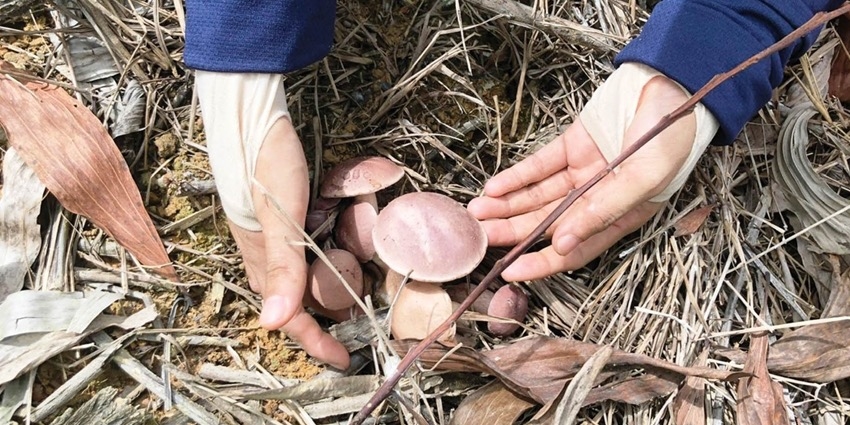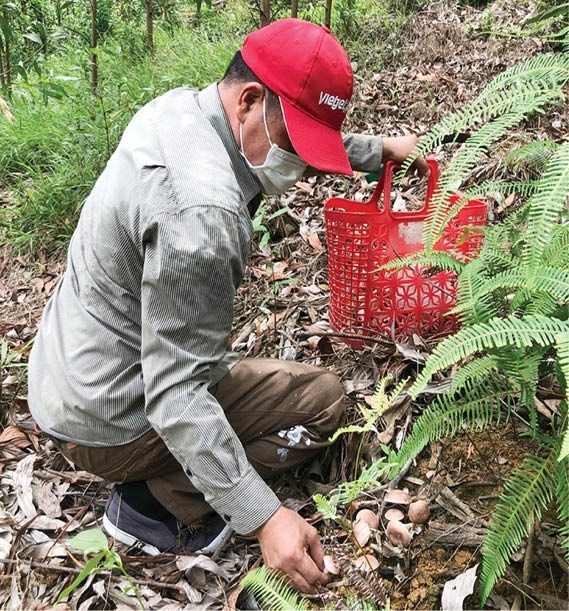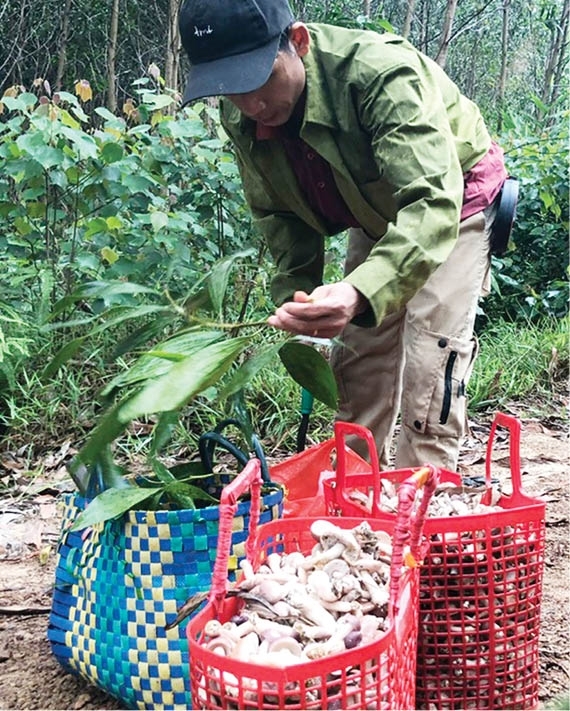 |
| Local people eagerly climb the mountains to pick melaleuca cajuput mushrooms |
1. At 1 AM, when roosters are just starting to crow sporadically from distant villages, Mrs. Thuy Phuong and her 38-year-old husband Le Hien, citizens of Huong Tho commune, Hue City, have already woken up. Loading a few baskets, two sickles, some water and snacks onto their motorbike, they leave home, heading towards the mountains. In the dim headlights, they begin their journey of over an hour by motorbike to reach the Melaleuca cajuput forests in Huong Binh commune, Huong Tra town, to search for melaleuca mushrooms.
At 2 AM, the trail along the melaleuca cajuput plantations in Huong Binh is crowded with parked motorbikes. The dark night forest suddenly becomes bustling with people as if they are attending a festival. Hundreds of flashlights sweep back and forth, voices calling out to each other. Mrs. Phuong explains that melaleuca cajuput mushrooms, like termite mushrooms, glow when light shines on them. So, finding mushrooms at night is even easier than during the day.
The melaleuca cajuput mushroom season starts from April to around July or August, when thunderstorms begin. After days of alternating sunshine and rain, with hot and humid weather taking turns, folk call this “mushroom-making weather.” And, mushrooms start to grow in the melaleuca cajuput forests. Each year, there can be 2 to 3 mushroom flushes, each lasting about 4 to 10 days, sometimes up to 15 days.
 |
Mrs. Phuong and her husband work in making votive objects paper, but when the mushroom season comes, they put aside their work to go mushroom picking. On days when mushrooms fetch good prices, the couple tries to make 3 trips a day. The first trip starts at 1 AM and lasts until 6 AM, after which they return to sell the mushrooms. At 9 AM they go back to the forest, returning at noon. In the afternoon, they make another trip. Each trip can yield 40-60kg of mushrooms. Being diligent and healthy, the couple can pick 100 to 150kg of mushrooms a day. With mushroom prices ranging from VND 30,000 to VND 60,000 per kilogram, sometimes the couple can earn several million dongs each day.
Professional mushroom pickers living around the Tuan junction area start flocking to the melaleuca cajuput forests in the communes of Hong Ha and Huong Nguyen, A Luoi district when the first rains fall on the forests to hunt for mushrooms. When rains move to lower areas like Binh Tien, Binh Thanh communes of Huong Tra town, or areas of Da Den, Da Bac, and Cay Mount of Hue City..., the mushroom pickers move along with them. According to Mrs. Phuong Huyen and Mrs. Le Diem, citizens of Huong Tho commune, Hue City, mushroom picking also demands intimate knowledge of the terrain and forest ecosystem. If one goes to unfamiliar forests, the sprawling Melaleuca cajuput plantations can quickly disorient pickers, making it challenging to find one’s way back.
 |
2. Standing at one end of Huu Trach bridge, one can see the bustling flow of people and vehicles on National Highway 49. Some carry mushrooms to the market to sell while others return with empty baskets after selling, heading back towards the forest. The busiest mushroom gathering point is usually in the Nam Giao Esplanade area. In case of market saturation, many sellers will move to other markets like An Cuu, Ben Ngu, Dong Ba, and No. On days when mushrooms are in high demand, mushroom wholesalers sometimes stand waiting at the Tuan bridge area to buy.
We followed a friend, joining the stream of people going up to the forest to find mushrooms. Parking the motorbike at the foot of the hill, then climbing up to the 2-3 year-old melaleuca cajuput plantation. By the time we reached the highest point of the plantation, mushrooms were sparse with only a few caps here and there, so the basket was only half-full with a few kilos. Vines, reeds, and broken branches constantly obstructed our steps. Breathing became labored. Sweat soaked through several layers of clothes. The forest was damp. Swarms of mosquitoes noisily attacked our faces and necks. It wasn’t until we crossed over the mountain peak and descended the other side that a patch of deep purple mushrooms appeared right in the middle of a plowed furrow. Mushrooms were densely sprouting, like a field freshly seeded. Suddenly, the fatigue vanished, replaced by excitement and thrill. The joy of picking mushrooms sometimes surpasses even monetary gains.
Many mushroom connoisseurs say that melaleuca cajuput mushrooms from the forests in Hue are more delicious than those from many other provinces. Hue’s melaleuca cajuput mushrooms have a spicy, sweet, rich flavor and are very crunchy within their bitterness, while mushrooms from other regions taste bitter, dry, and lack sweetness and richness. During times when mushrooms are cheap, pickers will boil and freeze them for sale instead of selling them fresh. A kilogram of frozen mushrooms costs between VND 55,000 and VND 75,000.
Mrs. Thanh Thuy, a citizen of Huong Tho commune, Hue City, says she picks mushrooms to freeze for gradual consumption and to send to relatives in Saigon. According to Mrs. Thuy, frozen melaleuca cajuput mushrooms from Hue sold in Saigon cost VND 75,000 - 85,000 /kg. Frozen melaleuca cajuput mushrooms from Quang Tri or Dong Nai cost less than VND 50,000/kg.
In a melaleuca cajuput mushroom season, many families can earn VND 30-50 million. As Mr. Nghe says, the income from one melaleuca cajuput mushroom season is even more valuable than the profit from growing one hectare of Melaleuca cajuput trees for 5 years. As for Mrs. Thuy Phuong and her husband, after each mushroom season, when school starts, the money from selling mushrooms is enough for them to prepare books, clothes, and fully cover tuition fees for their children. For many years, the arrival of mushroom season has painted smiles across faces beneath the shadowy canopies of melaleuca cajuput forests. Though bitter to the taste, these fungi yield a sweet harvest of prosperity for countless families.
